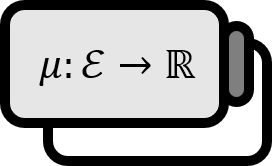General Definitions of Measure
Definition
Let $(X,\mathcal{E})$ be a measurable space. A function $\mu : \mathcal{E} \to \overline{\mathbb{R}}$ that takes extended real values is called a measure if it satisfies the following three conditions:
(a) $\mu ( \varnothing ) = 0$
(b) $\mu (E) \ge 0,\quad \forall E\in \mathcal{E}$
(c) Suppose $\left\{E_{j}\right\}$ are sequences of mutually disjoint sets in $\mathcal{E}$. Then the following holds:
$$ \mu \left( \bigcup _{j=1}^\infty E_{j} \right) =\sum \limits_{j=1}^\infty \mu (E_{j}) $$
The ordered pair $(X,\mathcal{E}, \mu)$ is called a measure space.
Two sets $E_{1}$, $E_2$ are said to be disjoint if they satisfy $E_{1} \cap E_2=\varnothing$.
Explanation
Replacing condition $\mu$ with $\mu\ :\ \mathcal{E} \rightarrow [0,\infty]$ includes (b), so it can be omitted.
Condition (c) refers to countable additivity. It’s important to note that it only applies to mutually disjoint sets.
When mentioning both signed measures and measures together, for emphasis, measures are also referred to as positive measures.
Properties
Let $(X,\mathcal{E},\mu)$ be a measure space.
(A) Monotonicity: If $E,F\in \mathcal{E}$ and $E\subset F$, then $\mu (E) \le \mu (F)$.
(B) Countable sub-additivity: If $\left\{ E_{j} \right\}_{1}^\infty$ are sequences of elements in $\mathcal{E}$, then $\mu \left( \bigcup_{1}^\infty E_{j} \right) \le \sum _{1}^\infty \mu (E_{j})$.
(C) Continuity from below: Suppose $\left\{ E_{j} \right\}_{1}^\infty \subset \mathcal{E}$ is a monotonically increasing sequence, i.e., $E_{1} \subset E_2 \subset \cdots$. Then the following holds: $$ \mu\left( \bigcup \nolimits _{1}^\infty E_{j} \right)= \lim \limits_{j\rightarrow \infty} \mu (E_{j}) $$
(D) Continuity from above: Suppose $\left\{ E_{j} \right\}_{1}^\infty \subset \mathcal{E}$ is a monotonically decreasing sequence, i.e., $E_{1} \supset E_2 \supset \cdots$. And let $\mu (E_{1})<\infty$. Then the following holds: $$ \mu\left(\bigcap \nolimits _{1}^\infty E_{j} \right)= \lim \limits_{j\rightarrow \infty} \mu (E_{j}) $$
Proof
(A)
Let’s say $E \subset F$. Then $F=F\setminus E+ E$ is true. Since $E$ and $F\setminus E$ are mutually disjoint, by the definition of measure (c), the following holds:
$$ \mu (F) = \mu (F\setminus E+ E) = \mu (F\setminus E) + \mu (E) $$
Then, by the definition of measure (b), the following holds:
$$ \mu (F\setminus E) + \mu (E) \ge \mu (E) $$
Therefore, the following is obtained:
$$ \mu (F) \ge \mu (E) $$
■
(B)
Let’s say $F_{1}=E_{1}$. And for $k>1$, say $F_{k}=E_{k} \setminus \left( \bigcup_{1}^{k-1} E_{j} \right)$. Then each $F_{k}$ is mutually disjoint and $\bigcup_{1}^n F_{j}=\bigcup_{1}^n E_{j},\ \forall n$. Also, for each $j$, $F_{j} \subset E_{j}$ holds. Therefore, the following holds:
$$ \mu \left( \bigcup \nolimits_{1}^\infty E_{j}\right)=\mu \left( \bigcup \nolimits_{1}^\infty F_{j}\right)=\sum \limits_{1}^\infty \mu (F_{j}) \le \sum \limits_{1}^\infty\mu (E_{j}) $$
The second equality holds because of the definition of measure (c). The last inequality is due to (A).
■
(C)
Let’s say $E_{0}:= \varnothing$. And let’s say $F_{j}=E_{j}\setminus E_{j-1}$. Then each $F_{j}$ is mutually disjoint. Also, $\bigcup _{1}^\infty F_{j} =\bigcup_{1}^\infty E_{j}$ holds. Therefore, the following holds:
$$ \begin{align*} \mu \left( \bigcup \nolimits_{1}^\infty E_{j}\right) &= \mu \left( \bigcup \nolimits_{1}^\infty F_{j}\right) \\ &= \sum_{1}^\infty \mu (F_{j}) \\ &= \sum \limits_{1}^\infty \mu (E_{j} \setminus E_{j-1} ) \\ &= \lim \limits_{n \rightarrow \infty} \sum \limits_{1} ^n \mu (E_{j}\setminus E_{j-1} ) \\ &= \lim \limits_{n \rightarrow \infty} \mu (E_{n}) \\ &= \lim \limits_{j \rightarrow \infty} \mu (E_{j}) \end{align*} $$
The second equality holds because of the definition of measure (c).
■
(D)
Let’s say $F_{j}=E_{1} \setminus E_{j}$. Then $F_{1} \subset F_2 \subset \cdots$ holds. Also, $\mu (E_{1})=\mu (F_{j})+\mu (E_{j})$, and $\bigcup_{1}^\infty F_{j}=E_{1} \setminus \left( \bigcap_{1}^\infty E_{j} \right)$ holds. Since $E_{1}= \bigcup_{1}^\infty F_{j}+\bigcap_{1}^\infty E_{j}$, the following holds:
$$ \begin{align*} \mu (E_{1}) &= \mu \left( \bigcap \nolimits_{1}^\infty E_{j}\right) + \mu \left( \bigcup \nolimits _{1}^\infty F_{j} \right) \\ &= \mu \left( \bigcap \nolimits_{1}^\infty E_{j}\right) + \lim \limits_{j \rightarrow \infty} \mu ( F_{j} ) \\ &= \mu \left( \bigcap \nolimits_{1}^\infty E_{j}\right) + \lim \limits_{j \rightarrow \infty}\big[ \mu ( E_{1} )-\mu (E_{j}) \big] \\ &= \mu ( E_{1} )+ \mu \left( \bigcap \nolimits_{1}^\infty E_{j}\right) -\lim \limits_{j \rightarrow \infty}\mu (E_{j}) \end{align*} $$
The second equality is due to (C). Since $\mu (E_{1}) < \infty$, the following is obtained:
$$ \mu \left( \bigcap \nolimits_{1}^\infty E_{j}\right) = \lim \limits_{j \rightarrow \infty}\mu (E_{j}) $$
■
